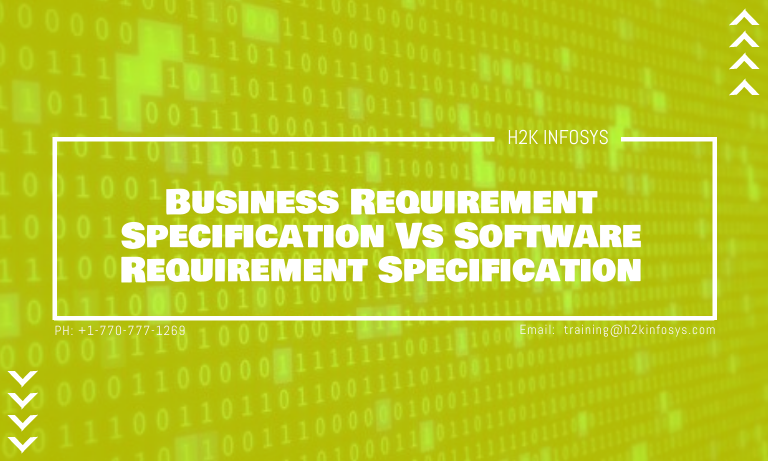There are specific kinds of requirement specifications that software development and testing professionals deal with when working on a new product.
A software development team needs clear and accurate requirements so that the right product can be created. Documentation is a vital process for the easy and efficient development of software.
There are various types of requirement specifications. They include Functional Requirement Specifications (FRS), Performance Requirement Specification (PRS), Configurations Requirement Specification (CRF), Business Requirement Specification (BRS), Reliability Requirement Specification (RRF), Compatibility Requirement Specification (CRF), and Software Requirement Specification (SRS). The common ones are the Software requirement specification (SRS), Business requirement specification (BRS), and Functional requirement specification (FRS).
These are the main types of documents that software developers use in software testing, which refers to the comprehensive requirements for a system based on the needs of the client. Also, a business analyst must have come across these terms when he/she is trying to document the project’s requirements.
In this tutorial, we’ll be looking at the Business Requirement Specification (BRS) and the Software Requirement Specification (SRS), and the difference between both of them.
What is Business Requirement Specification?
These are documents that enlist the objectives of the business that the client is trying to achieve, the key targets as well as the performance expectations of the products or system.
It also shows how the business requirements of the client are met on a wider level. It is called a High-level document and is one of the most common and universally accepted specification documents.
The Business Requirement Specification (BRS) is usually created at the start of the project life cycle. The BRS document created by a business analyst is usually based on the specification of other important stakeholders who are interacting with the final product after a rigorous analysis of the client company has taken place. The client then reviews the final copy of the document to validate all the expectations of the business stakeholders.
A BRS document is mainly used by product investors, middle and upper management as well as business analysts. A Business Requirement Specification (BRS) document generally consists of the complete scope of the project, the performance requirements and usability, the purpose of the product, the functions of the product, the features of the product and the users, the scope of the work and the humanity requirements.
Contrary to the case of Software requirement specification (SRS), tables, diagrams as well as use cases are not included in a BRS document. An example of a statement that can be found in a Business Requirement Specification (BRS) document could look like is ‘The Company would like to improve its efficiency by knowing the time spent on different tasks by the employees’. The BRS document answers the question of ‘Why are the requirements needed and what are the results to be expected from the system?
What about Software Requirement Specification?
Software Requirements Specification (SRS) is a document used in describing the main functionality and business purpose of a product, the software that is to be developed, and how the core functions of the software are to be performed.
It outlines the summary of a project which includes the features of the technology as well as the desired goal of the business. The SRS document is important as it bridges the gap between what the business will get by documenting the characteristics, broad layout, and workflows of the software being developed, and what the business wants.
Software Requirements Specification (SRS) serves as the basis of any project because it consists of a framework that each team member will follow. The SRS document answers the question of ‘What requirements must be fulfilled for the needs of the business to be met?
Stakeholders also make use of the Software Requirements Specification (SRS) as a base of contract which will include the details of how the future product will run, as well as the functionality of the product. SRS describes the process of how data flows into the system and the entire system flow. As the name suggests, this document is used mainly by software developers during the process of developing the program or product. The SRS document also enhances the efficiency during the process of developing the software. q
System analysts are the ones responsible for securing all the necessary information from the relevant stakeholders. They then share the information with the other departments. The project managers are the main audience of the Software Requirement Specification (SRS). Functional and non-functional requirements are found in SRS.
Contrary to the case of Business requirement specification (BRS); tables, diagrams as well as use cases are included in an SRS document. Descriptive labels should be present to serve as references to every diagram, figure, and table present in the document. For an SRS document to be deemed perfect, it must take into consideration the potential users and the way these users will interact with the software, coupled with the way the software relates with other software and also with hardware.
SRS provides a major advantage in software development by reducing frustration and non-productive time. It also helps the team members to work in synergy, making sure all the requirements are completed. Another name for the Software Requirement Specification (SRS) is Product Requirements Document (PRD). An example of a Software Requirement Specification (SRS) document is a proposed software that is designed to track the employee’s office time. The document, in this case, should include the login module, the employee module, the administrator module, and the reporting module.
Difference between BRS and SRS
| S/N | BRS | SRS |
| 1 | It is a formal document that describes the various requirements provided by the client. | It specifies the functional and non-functional requirements present in the software. |
| 2 | It is derived from the client’s requirements and the client’s interactions. | It is derived from the Business Requirements Specification (BRS). |
| 3 | it is created by a business analyst. | It is created by a system analyst or a system architect. Although, in some companies, the business analyst can also create an SRS. Some companies do not even have an SRS, instead, they make their BRS detailed enough so that it can be used as SRS. |
| 4 | It describes the functional specifications of the software at a very high level. | It describes the technical and functional specification of the software also at a high level. |
| 5 | It deals with aspects consisting of business requirements. | It deals with resources that the company provides. |
| 6 | It defines the exact wants of the customer. The document is used from the beginning to the end of the project. | It describes how the business functions when using the software or application. |
| 7 | Tables and use cases are not included. | Tables and use cases are included. |
| 8 | It uses all the types of requirements. | It explains the functional requirements and the non-functional requirements. |
| 9 | The business requirements in BRS are explained on a broad level. | It is a complete document describing how the system behaves when it is developed. |
| 10 | References for tables and diagrams may not be included. | References for tables and diagrams are included. |
| 11 | It lists the stakeholders as well as the user base. | It does not list any of the user base or the client. |
| 12 | The BRS document is gotten by interacting with the consumers and using their feedback for the requirements. | The SRS document is gotten from the Business Requirements Specification (BRS). |
Conclusion
Having a good understanding of the various specifications is vital for successful job performance. Knowing about the Business Requirement Specification (BRS) and the Software Requirement Specification (SRS) helps the business analyst and the system analyst work efficiently in their job roles, thereby increasing their productivity and quality of performance achieving good results. Also, knowing the difference between the Business Requirement Specification (BRS) and the Software Requirement Specification (SRS) is important in business analysis and software development.



























